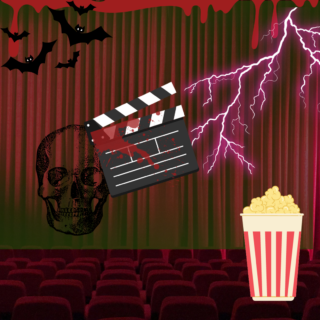
Christopher Plummer, the director of Rockland Community College’s Cultural Arts Theatre and co-founder of the Rockland Shakespeare Company, will never forget one of the very first horror movies he watched as a kid: “The Exorcist” (1973), directed by William Friedkin.
“‘The Exorcist’ terrified me in a way I can’t properly convey to you or quantify,” he said. “I watched it since many times and I remember distinctly seeing it as a child, but that was one movie that very very much scared me and I don’t get particularly scared at films.”
He was only 5 years old.
Plummer —who is a distant relative of the late actor Christopher Plummer, known for iconic films such as “The Sound of Music” (1965) and “Knives Out” (2019)— says that there’s a number of reasons why audiences flock toward the horror genre.
“I think people enjoy something that’s different, that might exhilarate them, get their heart pumping or frighten them in a way. They can escape into that into a short amount of time, and come back to their reality, be safe and kind of just go about their lives,” he said. “It’s a quick jolt. It’s a small little pit stop of escapism to experience something that’s different or unusual. It breaks the mundane everyday lives that we sort of find ourselves in even though our normal lives can be quite exciting.”
Plummer says that the genre is very broad and made of so many different subgenres.
“At the dawn of film, I think the pioneers of the horror genre didn’t even know what they were really creating and we sort of retroactively labeled them as ‘horror films’,” he said. “It wasn’t probably until the Golden Age that the genre was really born or at least acknowledged.”
Audio, Plummer says, is one very crucial aspect of filmmaking.
“Musical scores in the silent era were critical because they didn’t have talkies yet,” he said.
For films like Steven Spielberg’s “Jaws” (1975), music played a huge role in the film’s success and helped keep it afloat, serving as a lifesaver, with the original Bruces falling apart for having not been made with materials adapted for saltwater.
“You didn’t even need to see blood and guts, you heard that music and you saw the darkness in the water,” Plummer said. “When is the shark going to bite somebody? When is it going to come out of the water? When is it going to sneak up?”
The audio enhanced the psychological terror of the film.
One pioneer filmmaker that shaped psychological terror is Alfred Hitchcock.
“Alfred Hitchock is known for suspense. We used to call it the 13 bumps. When you’re writing a suspense screenplay you have to put 13 bumps in it to keep the audience on their toes,” he said.
As the genre evolved over time, screenwriters added more and more.
“I don’t even think that Hitchock realized that he started the slasher genre with ‘Psycho’ (1960). The slasher films that came into prominence in the late 70s and early 80s really owe a debt of gratitude to Hitchcock,” Plummer said, referencing iconic films such as John Carpenter’s “Halloween” (1978) and Wes Craven’s “A Nightmare on Elm Street” (1984).
Regardless of what elements constitute a great horror film, there’s no doubt that scary movies originated from books and storytelling.
“When you talk about the evolution of horror, it really emanates with stories, not just novels, but written words that were handed down and translated, and things like that. They really came into prominence with the gothic era with Mary Shelley’s ‘Frankenstein’ and Bram Stoker’s ‘Dracula.’ Ultimately, all of those were adapted into films,” Plummer said.

In fact, Plummer describes gothic literature as “the genesis of the horror film.”
“The Blair Witch Project” (1999), which catapulted the popularity of “found-footage” style movies, is one prime example that took gothic elements and mixed them with old techniques, all while at the same time having a low budget and shooting it improv.
“We always go back to the story, the spoken word, the spoken tale that’s retold again and again. We have that in all of our culture throughout the world,” Plummer said.
The award-winning Visual and Performing Arts Department at RCC currently offers classes and degree tracks in a number of fields, including Cinema Studies and Filmmaking.
For more information, you can visit their website at sunyrockland.edu.
Be sure to follow @cait_malilay_writes for future articles.
You can also email her at [email protected] for news tips or stories.

You must be logged in to post a comment Login